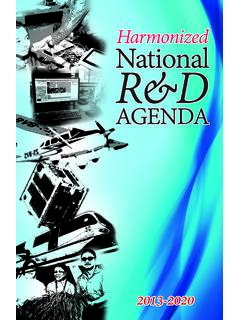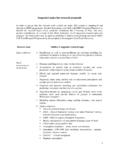Transcription of HNRDA 2017-2022 | Page 1 - www.dost.gov.ph
1 HNRDA 2017-2022 | Page 1 HNRDA 2017-2022 | Page 2 Table of Contents Page No. Acronyms 5 Introduction 7 Harmonized National R&D Agenda ( HNRDA ) Framework 8 SECTION I National Integrated Basic Research Agenda (NIBRA) 10 SECTION II Health 16 SECTION III Agriculture, Aquatic and Natural Resources (AANR) 26 SECTION IV Industry, Energy and Emerging Technology 33 SECTION V Disaster Risk Reduction and Climate Change Adaptation (DRR & CCA) 40 HNRDA 2017-2022 | Page 3 Table of Contents Page No.
2 Annexes: Roadmaps 46 NIBRA Annex 1 TUBIG Program (Tubig ay Buhayin at Ingatan) SAPAT Program (Saganang Pagkain Para sa Lahat) 47 Annex 2 LIKAS Program (Likas Yaman sa Kalusugan) ALERT Program (Alternative Energy Research Trends) 48 Annex 3 SAKLAW Program (Saklolo sa Lawa) 49 Annex 4 ATIN Program (Ang Tinig Natin) 50 Health Annex 5 National Unified Health Research Agenda 51 Agriculture, Aquatic and Natural Resources (AANR) Annex 6 Crops: Abaca | Banana 53 Annex 7 Crops: Coconut | Coffee 54 Annex 8 Crops: Legumes - Mungbean | Peanut 55 Annex 9 Crops: Mango | Rice 56 Annex 10 Crops: Rootcrops - Sweet Potato Crops: Sugarcane 57 Annex 11 Crops: Tropical Fruits - Citrus | Durian 58 Annex 12 Crops: Tropical Fruits - Papaya | Pineapple 59 Annex 13 Crops: Tropical Fruits - Pummelo Crops: Vegetables 60 Annex 14 Livestock: Dairy | Duck 61 Annex 15 Livestock: Dairy Goat | Slaughter Goat 62 Annex 16 Livestock: Native Chicken | Native Pig 63 Annex 17 Livestock: Swine | Feed Resources 64 Annex 18 Aquatic: Inland - Aquafeeds | Mangrove Crab 65 Annex 19 Aquatic: Inland - Milkfish | Mussel 66 Annex 20 Aquatic: Inland - Shrimp | Tilapia 67 Annex 21 Aquatic: Marine - Abalone | Blue Swimming Crab 68 Annex 22 Aquatic: Marine - Oyster | Sardines 69 Annex 23 Aquatic: Marine - Sea Cucumber | Seaweeds 70 Annex 24 Aquatic: Marine - Tuna Forestry & Natural Resources: Bamboo 71 Annex 25 Forestry & Natural Resources.
3 Cacao | Industrial Tree Plantation 72 Annex 26 Forestry & Natural Resources: Rubber Environmental Services: Biodiversity 73 Annex 27 Environmental Services: Corals 74 Annex 28 Environmental Services: Climate Change | Watershed 75 HNRDA 2017-2022 | Page 4 Table of Contents Page No. Industry, Energy and Emerging Technology Annex 29-30 Competitive Industries: ICT, Electronics and Semiconductor 76 Annex 31 Delivery of Social Services: DRR/CCA 78 Annex 32-34 Delivery of Social Services: Space Technology Application 79 Annex 35-39 Intelligent Transportation Solutions 82 Annex 40-41 Renewable Energy and Energy Storage Solutions 87 Disaster Risk Reduction and Climate Change Adaptation Annex 42 DRR-CCA R&D Roadmap 89 Annex 43 PAGASA Roadmap 90 HNRDA 2017-2022 | Page 5 Acronyms Acronym Definition AANR Agriculture.
4 Aquatic and Natural Resources AIS Automatic identification system ALERT Program Alternative Energy Research Trends Program ATIN Program Ang Tinig Natin Program BMI Body mass index CCTV Closed-circuit television CHED Commission on Higher Education CVD Cardiovascular disease DNA Deoxyribonucleic acid DOH Department of Health DOST Department of Science and Technology DRR & CCA Disaster Risk Reduction and Climate Change Adaptation ENGP Enhanced National Greening Program FGD Focused Group Discussion GIT Gastrointestinal tract GNSS Global navigation satellite system GUT Genitourinary tract H2S Hydrogen sulfide HAB Harmful algal bloom HNRDA Harmonized National Research and Development Agenda HIV AIDS Human immunodeficiency virus and acquired immunodeficiency syndrome HIW High- impact Weather HYV High yielding variety ICT Information and Communication Technology IEC Information Education and Communication ITS Intelligent transportation system IVM Integrated vector management LIKAS Program Likas Yaman sa Kalusugan Program MSME Micro, small and medium enterprise NGA National Government Agency HNRDA 2017-2022 | Page 6 NIBRA National Integrated Basic Research Agenda NIH-UPM National Institutes of Health.
5 University of the Philippines Manila NRCP National Research Council of the Philippines NRDC National Research and Development Conference NUHRA National Unified Health Research Agenda PCAARRD Philippine Council for Agriculture, Aquatic and Natural Resources Research and Development PAGASA Philippine Atmospheric, Geophysical and Astronomical Services Administration PCHRD Philippine Council for Health Research and Development PCIEERD Philippine Council for Industry, Energy and Emerging Technology Research and Development PES Payment for Environmental Services PHIVOLCS Philippine Institute of Volcanology and Seismology PNHRS Philippine National Health Research System PWD Persons with disabilities PTC Positive Train Control PUV Public Utility Vehicle QPF Quantitative Precipitation Forecasting R&D Research and Development RE Renewable Energy RFID Radio Frequency Identification RUTF Ready to use therapeutic food SAKLAW Program Saklolo sa Lawa Program SAPAT Program Saganang Pagkain Para sa Lahat Program SCP Solar Power Concentrators SDG Sustainable Development Goal SHC Solar heating and cooling STA Space Technology Application T2DM Type 2 Diabetes Mellitus TUBIG Program Tubig ay
6 Buhayin at Ingatan Program UAV Unmanned Aerial Vehicles UN United Nations WSN Wireless Sensor Network XDP X-linked Dystonia-Parkinsonism Syndrome HNRDA 2017-2022 | Page 7 Introduction The DOST, in consultation with government and private research and development institutions, the academe, industry and other concerned agencies, prepared the Harmonized National R&D Agenda ( HNRDA ) 2017-2022 to ensure that results of S&T endeavors are geared towards and are utilized in areas of maximum economic and social benefit for the people. The formulation of the HNRDA is in line with the DOST s mandate of providing central direction, leadership and coordination of the scientific and technological efforts in the country.
7 The HNRDA is aligned with AmBisyon Natin 2040: matatag, maginhawa at panatag na buhay para sa lahat. It has three pillars: Malasakit (enhancing the social fabric), Pagbabago (reducing inequality) and Kaunlaran (increasing potential growth). AmBisyon Natin 2040 and the three pillars form the foundation for more inclusive growth, a high-trust and resilient society and a globally competitive knowledge economy. On 21 October 2016, the DOST hosted the 1st National R&D Conference (NRDC) to harmonize the country s research and development priorities and align them with the thrusts of the current administration. Comments and recommendations raised during the 1st NRDC were considered in the final version of the HNRDA which was presented to stakeholders during the 2nd National R&D Conference on 15 February 2017.
8 One of the outcomes identified in the Philippine Development Plan 2017-2022 is to increase the country's potential growth by building the foundation for a globally competitive knowledge economy where accelerated technology adoption and stimulated innovation are envisioned to be achieved. The HNRDA , therefore, articulates our national priorities and will serve as guide for public investment in R&D while ensuring a cohesive convergence and integration of R&D efforts towards the shared goal of inclusive socio-economic growth and a better life for Filipinos. The HNRDA is organized into 5 sectors: Basic Research; Agriculture Aquatic and Natural Resources; Health; Industry, Energy and Emerging Technology; and Disaster Risk Reduction and Climate Change Adaptation.
9 The Agenda was formulated by the National Research Council of the Philippines (NRCP), Philippine Council for Agriculture, Aquatic and Natural Resources Research and Development (PCAARRD), Philippine Council for Health Research and Development (PCHRD), Philippine Council for Industry, Energy and Emerging Technology Research and Development (PCIEERD), Philippine Institute of Volcanology and Seismology (PHIVOLCS), and Philippine Atmospheric, Geophysical and Astronomical Services Administration (PAGASA) in cooperation with stakeholders in the respective sectors. HNRDA 2017-2022 | Page 8 The Harmonized National Research and Development Agenda ( HNRDA ) is divided into five (5) sectors.
10 It is aligned with AmBisyon Natin 2040, and is founded on the three pillars of Malasakit, Pagbabago and Kaunlaran. HNRDA 2017-2022 | Page 9 HNRDA 2017-2022 | Page 10 SECTION I National Integrated Basic Research Agenda (NIBRA) 2017-2022 The National Research Council of the Philippines (NRCP), a collegial body of over four thousand researchers, scientists, and experts, is mandated to promote and support fundamental and basic research in the country as provided in the 9th Philippine Legislature Act No.


